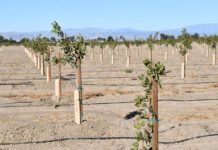
Leaders within the California tree nut industry expressed confidence in the industry’s future during a rare meeting of the minds between the industry’s top executives.
In a recent panel discussion during West Coast Nut magazine’s California Tree Nut Conference in November, top industry executives for four tree nut commodities—almond, pistachio, walnut and pecan—came together to discuss issues that the industry is dealing with now and what the future holds.
The executives in attendance were Richard Matoian, president of American Pistachio Growers; Michelle Connelly, executive director of California Walnut Board; Emily Fleischmann, vice president of global marketing for Almond Board of California; and Mark Hendrixson, president of California Pecan Growers Association.
Collaboration is Necessary
Making sure that all segments of the tree nut industry are in tandem with each other is key to succeeding now and in the future. Connelly said, and the executives agreed, that the industry as a whole is “stronger when it works together.”
“When it comes to ways that we’ve collaborated over the years, we have and will continue to collaborate,” Connelly said. “We have jointly funded research to continue supporting vital resources for the industry.”
A large area of collaboration is funded research into nutritional assets of nut crops. The International Tree Nut Council Nutrition Research & Education Foundation is the main organization that the industry collectively puts money into to study nutrition and health, according to Matoian.
“The goal behind that group is to represent the tree nut industry collectively in the areas of nutrition and health research,” Matoian said. “We feel that by putting our monies together [here], we can do a whole lot more than we could individually. Our commodities have a lot of similar properties that are beneficial to nutrition and health, even though we have our own areas that we stand out in.”
While nutrition and health research is a major point for collaboration, the tree nut industry works together in every aspect to promote and further the entire industry.
“When there are various issues or topics that come up and cut across all of our commodities, we end up talking with one another,” Matoian said. “What generally affects one affects all of us.”
Current Regulatory Issues
The agriculture industry as a whole experiences endless regulatory issues, and the tree nut industry is no different. The executives noted that the hardest-hitting regulations for the tree nut industry relate to water, food safety and pesticides.
Concerning water regulations, the Sustainable Groundwater Management Act, according to Matoian, is a topic that has consistently been on growers’ minds. The act went into effect at the beginning of 2020, and growers “likely won’t see results for the first few years while it is slowly being implemented,” Matoian said.
“Water is going to continue being an issue in California for years to come,” Fleischman added.
Food safety is another regulatory issue, and as is the case with regulations in general, cost is a main consequence.
“One example [for food safety] that I can think of are growers that may be looking to roast nuts instead of sell them raw,” Matoian said. “Once you roast, that now puts you into the Ready to Eat category, which brings on much greater regulations and higher standards.”
It all comes down to cost,” Matoian continued. “The cost for implementing more food safety regulations and having a food product that is ready to eat by the consumer will be higher. You have to have the proper kill step for the various pathogens that are out there.”
Pesticide regulations also pose some of the biggest challenges for growers. When chemicals such as chlorpyrifos and glyphosate are being heavily scrutinized, growers can have a difficult time finding alternative solutions.
“Growers are losing tools, some of which are good tools with good safety records that don’t necessarily have a risk management issue associated with them for consumers,” Matoian said. “But because of concerns out there that may be placed in the media, it causes there to be a trickle-down effect back to the grower about what they may or may not be able to use in their field, even if it is a safe and registered product.”
“The regulatory environment is not decreasing by any means, but our growers recognize that they are good environmental stewards,” Connelly said. “Anything that we can do as industry associations working together to help tell that story is important, and we want to be the most efficient users of resources. The more we can work together, the better.”
Silver Linings
The executives were all in agreement that their individual commodities as well as the tree nut industry have bright futures. While regulations, tariffs and COVID-19 have created issues, the industry is still stable.
The pistachio industry has experienced some hardships with competition and tariffs, according to Matoian, but this allows the industry room for vast improvement in the future. COVID-19, on the other hand, may actually help pistachios.
“Relative to COVID-19, it can potentially work in our favor in terms of peoples’ eating habits,” Matoian said. “We actually did see a consumption and purchasing increase in our products domestically during some of the early COVID-19 months, so that was a positive. I think that long-term, the future looks positive for us.”
The pecan industry, while relatively small in California compared to pistachios, walnuts and almonds, has also seen continued success in the market as a result of the Federal Marketing Order, according to Hendrixson.
“The Federal Marketing Order has been able to do research and promote health benefits for pecans that have previously not been done,” Hendrixson said. “That’s improving recognition for pecans as a good and healthy choice for consumers.”
While tariffs have put a damper on the almond industry’s ability to move a three-billion-pound crop, there are some silver linings.
“Tariffs have affected the almond industry tremendously in China, but there is now an exemption that is reducing those a bit and bringing volume back,” Fleischman said. “Hopefully those will subside in the long term because there is obviously tremendous opportunity in that market to come.
“The one thing that has been impressive to me is the industry engagement that helps fuel the Almond Board as well as other organizations,” she continued. “That’s really important. Encourage growers to get involved if they are not already.”
Walnuts have also seen a record crop this year at around 1.5 billion pounds, according to Connelly. As are the pecan, almond and pistachio industries, the walnut industry is continuing to find positives within the current world atmosphere.
“Some of the trends that we’re seeing come out of the COVID-19 pandemic are really helping to fuel consumption [for walnuts] in different ways, which is exciting,” Connelly said. “That’s helping to mitigate some of those shorter-term challenges that we’re seeing from food service sector retraction.
“We have a lot of room to improve,” she continued, “and are continuing to diversify our portfolio to do that as we grow our markets around the world.”
Connelly and the other panelists noted that the major associations within the tree nut industry and their executives are working hard to improve the industry for growers and consumers alike and will continue to do so in the future.
“We’re advocating, we’re out there on your behalf working to fight the tariffs and regulatory hurdles that we encounter on a regular basis,” Connelly said. “We’re really excited that the programs that the industry has and the investments it makes adds value and has grown our industry.”















